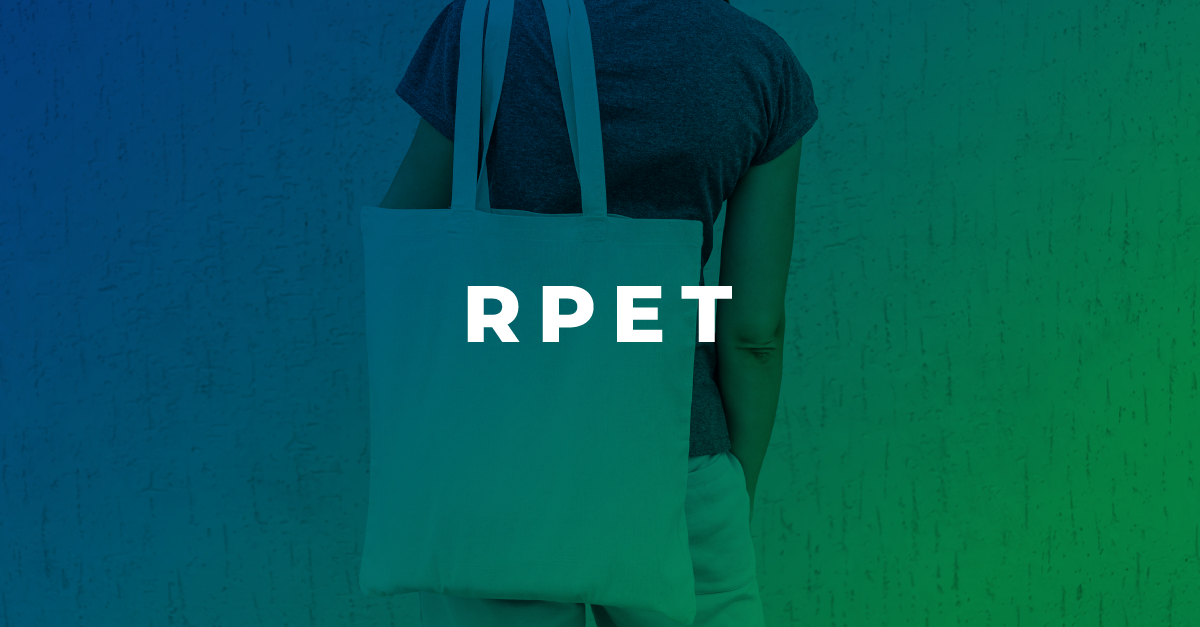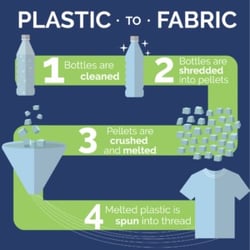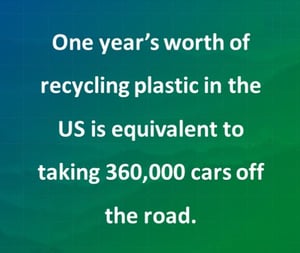
Plastic is commonly used all over the world. It's clean, robust, cheap and has revolutionised many industries & business sectors over the past 80 years. However, its negative impact on the environment is well-known and plastic pollution has become one of the world's most challenging environmental issues. As global consumption of disposable plastic products continues to increase, can recycled plastic present a solution? Or are we just shifting the problem around...
Lets start with Plastic (PET)
PET is an abbreviation for the much longer term, polyethylene terephthalate; a polymer of ethylene glycol and terephthalic acid. It is the most common type of plastic resin. To create virgin PET, producers extract crude oil and natural gas from the Earth, then process and heat it to form a molten liquid. They spin this liquid into fibres to create polyester fabric, or they mould and solidify it into PET plastic containers. As a fibre, polyester can be used to make anything from clothing and blankets to sleeping bags and carpeting. It is usually called polyester in this form, whereas in moulded containers, PET is the more common name. In its plastic form, PET is used to hold anything from food to cleaning solutions, mouthwash, and medication.
PET is considered a highly recyclable plastic. Used PET containers can be washed and re-melted into plasma, from which new items can be crafted. However, it can be really hard to collect clean, high quality plastics. This means very few PET containers can re-enter the cycle as food-grade containers. Less than half of plastic bottles purchased each year make it to recycling facilities. Only around 7% of those recycled are turned back into usable bottles. Manufacturers may not always be able to turn all salvaged plastic into new containers, but these other plastics may find a new calling as recycled polyester fabric, or rPET. This recycled polyester fabric can be used to make products including backpacks, leggings, t-shirts, and reusable grocery bags.
What is rPET?
 PET is easy to recycle. You can usually distinguish PET products by their #1 recycling label, and most recycling programs accept them, depending on their shape. Since there is enough plastic trash in our landfills already, by recycling PET products, we’re offering them a second life.
PET is easy to recycle. You can usually distinguish PET products by their #1 recycling label, and most recycling programs accept them, depending on their shape. Since there is enough plastic trash in our landfills already, by recycling PET products, we’re offering them a second life.
Recycling plastics also helps decrease the amount of plastic waste that enters landfills. Plastics in landfills take thousands of years to break down, and can leach toxic chemicals into the Earth. These chemicals can make their way into groundwater reserves, endangering both humans and animals. Plastics that “break down”, only do so into smaller pieces of plastic, which are still harmful to the ecosystems they may end up in. Recycling not only provides a better option than the landfill, it also has the ability to greatly decrease our resource extraction. Over 60% of first-time PET production is used to create polyester textiles. By using PET that has already been in circulation, we’re offsetting the amount of new PET that needs to be created.
 Creating a plastic water bottle from 100% recycled content uses 75% less energy than its virgin counterpart. Although some energy and water is still needed to process these plastics into new forms, the amount is significantly less than creating first-time plastics. This translates to less resource extraction, which protects the natural landscapes where oil and natural gas are extracted.
Creating a plastic water bottle from 100% recycled content uses 75% less energy than its virgin counterpart. Although some energy and water is still needed to process these plastics into new forms, the amount is significantly less than creating first-time plastics. This translates to less resource extraction, which protects the natural landscapes where oil and natural gas are extracted.
This also means that there is less carbon emitted during the creation of new products. For example, one year’s worth of recycling common plastics in the US can create the equivalent energy savings of taking 360,000 cars off the road.
Environmental Impact
It’s great that PET is so easily recyclable–but it’s still a plastic, and that has downsides. In its fabric form, polyester and rPET fabrics contain tiny fibres that can cause a big problem. Every time synthetic fabric is washed, hundreds of thousands of these small plastic particles are released into the water. These eventually make their way into places like lakes, rivers, and the ocean. Once in these environments, these micro plastics not only pollute the water, but also harm the animals that live in it. When these animals ingest micro plastics, the particles can get tangled up in their digestive tracts and disrupt the normal function of their bodies. As we consume animals that live in these waters, we also end up ingesting plastics, harming our own bodies too.
Furthermore, the physical process of recycling PET can also have negative impacts on the environment. Although creating a product from recycled plastic requires far less energy than creating first-time plastic, it still creates some challenges. Melting down recycled plastics releases volatile organic compounds that are harmful to the environment and wildlife surrounding the production site. Plus, the carbon emissions released in the process only furthers environmental degradation.
PET material in good condition can be used to create products of equal value, but it’s difficult for recycling facilities to produce pristine, well sorted plastics. This means that a lot of recycled plastic can’t create products of the same quality. Instead, many of these plastics are downcycled (used to create products of lesser value). To make the cut, producers of higher quality products like food-grade containers and bottles often still turn to creating new PET.
The verdict?
Recycling PET isn’t a perfect solution, and it doesn’t solve the problem that, once plastic is made, it’s here to stay for a very long time. Finding a new life for these already-made products, however, is definitely a step in the right direction. On top of using products made with recycled materials, it’s important that consumers are aware of their purchases and avoid single use plastics whenever possible.
Therefore, yes, choosing items that are made from rPET is more sustainable than choosing items made from virgin plastic, but don’t forget to do your research on other alternatives. We don’t want to create more waste just to make use of the waste we already have.
In order to truly reduce plastic pollution, we need to build products that last and actually remove the plastic from the waste cycle. We should ideally use any item until the end of its natural life, and consuming more resources to replace it really isn’t a long-term solution to the world's plastic problem.
Do you want to learn more about sustainable materials and generate ideas to create more environmentally friendly marketing campaigns? ASL's experts are on hand to provide guidance and support. Why not book a free Sustainability Workshop for your marketing team - we will build a bespoke, interactive workshop session tailored specifically to your brand, delivered in person or online, as required.
Contact us to book your Sustainability Workshop today
ASL Global is committed to conducting our business in a responsible & sustainable way. Acting with passion and integrity, our people work with customers, suppliers and other stakeholders to make a positive contribution to social responsibility and environmental sustainability in communities around the world.

Discover more about our ONE WORLD initiative







